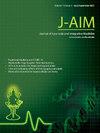综合治疗糖尿病足溃疡1例
IF 1.9
Q3 INTEGRATIVE & COMPLEMENTARY MEDICINE
引用次数: 0
摘要
糖尿病足溃疡(DFUs)发生在15 - 25%的糖尿病患者在其一生中的某个时刻。脓毒区广泛的外科清创是糖尿病足溃疡治疗的基石。有必要探索DFU的替代疗法,以降低严重截肢的风险。一名50岁男性因右前脚足底慢性溃疡就诊阿育吠陀门诊,溃疡已持续两个月。阿育吠陀考虑了Dushta vrana(败血性无法愈合的溃疡),并提到了vrana upkrama(伤口护理措施)。在这些Vrana upkrama中,Jalauka avcharana(水蛭放血)、parheka的Vrana Shodhana(伤口清洁措施)(药液治疗流)、Vrana ropana(伤口愈合措施)是三种主要的伤口护理方法,以及本病例中用于治疗糖尿病足溃疡的三个月的Shamana(姑息治疗)。使用DMIST工具评估基线和随访期间的伤口护理。经过3个月的治疗,综合方法有效缩短了DFUs的愈合时间,降低了截肢率,提高了DFUs患者多种阿育吠陀治疗的生活水平。本文章由计算机程序翻译,如有差异,请以英文原文为准。
Healingwith integrative management of Diabetic foot ulcer - A case report
Diabetic foot ulcers (DFUs) occur in 15–25 % of diabetic patients at some point in their lifetime. The wide surgical debridement of the septic area is the cornerstone of diabetic foot ulcer treatment. There is a need to explore alternate therapies for DFU to reduce the risk of severe amputation. A 50-year-old male visited the Ayurveda OPD with a chronic ulcer on the plantar aspect of his right forefoot, which had persisted for two months. Ayurveda has considered Dushta vrana (∼septic nonhealing ulcer) and mentioned the Vrana upkrama (∼wound care measures) for its management. Among these Vrana upkrama, Jalauka avcharana (∼bloodletting using leech), Vrana Shodhana (∼wound cleansing measures) by Parisheka (∼therapeutic streaming of medicated decoction), Vrana ropana (∼wound-healing measures) are the three main wound care approaches along with Shamana (∼palliative therapy) for three months adopted in the present case for managing diabetic foot ulcers. DMIST tool was used to assess wound care at baseline and during follow-up. After three months of treatment, the integrated approach effectively shortens the healing time of DFUs, reduces the amputation rate and improves the standard of living of patients with DFUs with multiple Ayurvedic treatments.
求助全文
通过发布文献求助,成功后即可免费获取论文全文。
去求助
来源期刊

Journal of Ayurveda and Integrative Medicine
INTEGRATIVE & COMPLEMENTARY MEDICINE-
CiteScore
4.70
自引率
12.50%
发文量
136
审稿时长
30 weeks
 求助内容:
求助内容: 应助结果提醒方式:
应助结果提醒方式:


